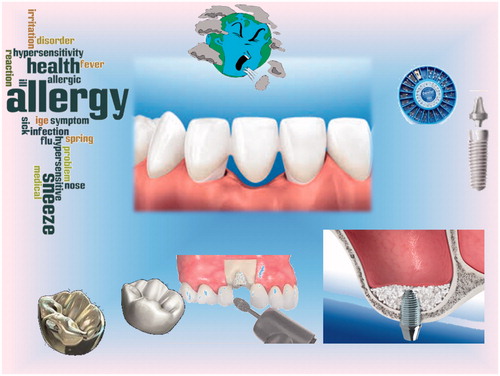Recently due to the environmental and ecosystemic changes caused by air pollution, impurities of foods and water, and exposure to enormous electromagnetic waves we have greater concern regarding the release of inorganic trace elements from different materials that can have drastic effects on life of biological cells, tissues, and organs. Inorganic trace elements are essential substances, and in trace amounts () play critical roles in many physiological and pathological processes.[Citation1] One of the most important processes is angiogenesis, the formation of new blood vessels from preexisting capillaries.[Citation2] Angiogenesis has great influence on physiological conditions such as regeneration and reparation processes, as well as pathological conditions including malignancies and tumorigenesis.[Citation3] In dentistry, angiogenesis plays a great role in regeneration of dentin and dental pulp tissues after injuries, and has utmost importance in revascularization of traumatic premature teeth, which results in radicular dental pulp survival and continuity of root formation.[Citation4,Citation5]
Figure 1. The effect of restorative biomaterials on surrounding tissue and its consequence effects on maxillofacial tissue.

There is a body of evidence indicating that trace elements can induce the angiogenesis process.[Citation1,Citation6,Citation7] Many of these elements can be found in dental biomaterials, which are leachable from the applied area.[Citation8–15] Releasing trace elements from dental materials include: restorative materials such as dental amalgam (Hg, Ag, Sn, Cu, Zn, Pd),[Citation8] and glass ionomers (Ca, P, Al, Sr, F),[Citation9] dental casting alloys (Au, Ag, Cu, Pd),[Citation10] endodontic metal instruments (SS, Ni, Ti),[Citation11] and calcium silicate-based cements (Ca, Si, As, Pb, Al),[Citation12] orthodontic appliances (Mg, Al, Si, P, S, K, Ca, Ti, V, Mn, Fe, Co, Cu, Zn, Ni, Cr),[Citation13,Citation14] and dental implants (Ti, Al, Co, Cr, Mo, Ni, V).[Citation15] These articles reviewed more than 500 articles regarding the effects of different trace elements on angiogenesis. Among these trace elements, Ca, P, Cu, and S present pro-angiogenic activity, while Ti nanoparticles, Au nanoparticles (AuNPs), Si nanoparticles, Cr, Zn, As, and V have anti-angiogenic properties. Fe can be both pro- or anti-angiogenic depending on the context presented.[Citation1,Citation6,Citation7,Citation16]
According to these facts, it is evident that inorganic trace elements have undeniable influence on angiogenesis events. Hence, the release of these elements from biomaterials used in dentistry can affect angiogenesis in surrounding tissues. We suggest that the pro- or anti-angiogenic properties of trace elements should be considered during dental biomaterial manufacturing, and their application under different treatment modalities. The angiogenic activity can act as a double edged sword. It can lead to a better regeneration and healing, or result in necrosis of biological tissues that might jeopardize the dental treatment outcomes.
Disclosure statement
The authors report no conflicts of interest. The authors alone are responsible for the content and writing of this article.
References
- Saghiri MA, Orangi J, Asatourian A, et al. Functional role of inorganic trace elements in angiogenesis part III: (Ti, Li, Ce, As, Hg, Va, Nb and Pb). J Crit Rev Oncol Hematol. 2016;98:290–301.
- Saghiri MA, Asatourian A, Sheibani N. Angiogenesis in regenerative dentistry. J Oral Surg Oral Med Oral Pathol. Oral Radiol 2015;119:122.
- Carmeliet P, Jain RK. Angiogenesis in cancer and other diseases. J Nature. 2000;407:249–257.
- Saghiri MA, Asatourian A, Sorenson CM, et al. Role of angiogenesis in endodontics: contributions of stem cells and proangiogenic and antiangiogenic factors to dental pulp regeneration. J Endod. 2015;41:797–803.
- Saghiri MA, Asatourian A, Garcia-Godoy F, et al. Effect of biomaterial on angiogenesis during vital pulp therapy. Dental Mat J Accepted 2016; in press.
- Saghiri MA, Asatourian A, Orangi J, et al. Functional role of inorganic trace elements in angiogenesis—Part I: N, Fe, Se, P, Au, and Ca. J Crit Rev Oncol Hematol. 2015;96:129–142.
- Saghiri MA, Asatourian A, Orangi J, et al. Functional role of inorganic trace elements in angiogenesis—Part II: Cr, Si, Zn, Cu, and S. J Crit Rev Oncol Hematol. 2015;96:143–155.
- Saghiri MA, Banava S, Sabzian MA, et al. Correlation between long-term in vivo amalgam restorations and the presence of heavy elements in the dental pulp. J Trace Elem Med Biol. 2014;28:200–204.
- Zilberman U. Ion exchanges between glass-ionomer restorative material and primary teeth components – an in vivo study. Oral Biol Dentist. 2014;2:1–5.
- Wataha JC, Lockwood PE. Release of elements from dental casting alloys into cell-culture medium over 10 months. J Dent Mater. 1998;14:158–163.
- Saghiri MA, Sheibani N, Garcia-Godoy F, et al. Correlation between endodontic broken instrument and nickel level in urine. J Biol Trace Elem Res. 2013;155:114–118.
- Camilleri J, Kralj P, Veber M, et al. Characterization and analyses of acid-extractable and leached trace elements in dental cements. Int Endod J. 2012;45:737–743.
- Mikulewicz M, Chojnacka K, Woźniak B, et al. Release of metal ions from orthodontic appliances: an in vitro study. Biol Trace Elem Res. 2012;146:272–280.
- Saghiri MA, Orangi J, Asatourian A, et al. Effect of mobile phone use on metal ion release from fixed orthodontic appliances. Am J Orthod Dentofacial Orthop. 2015;147:719–724.
- Lugowski SJ, Smith DC, McHugh AD, et al. Release of metal ions from dental implant materials in vivo: determination of Al, Co, Cr, Mo, Ni, V, and Ti in organ tissue. J Biomed Mater Res. 1991;25:1443–1458.
- Matusiewicz H. Potential release of in vivo trace metals from metallic medical implants in the human body: from ions to nanoparticles ? a systematic analytical review. Acta Biomater. 2014;10:2379–2403.
